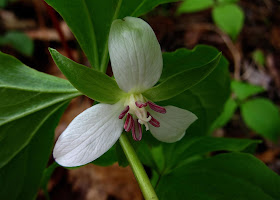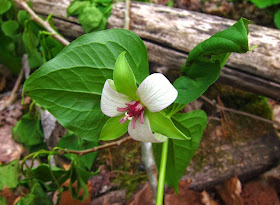When I reached the bridge a few yards further along the trail, I discovered why the water level had lowered so dramatically from just the week before. Over the past couple of years, beaver dams had completely blocked the stream that empties this wetland, but in just the past few days, work crews had performed the monumental task of opening parts of the beaver dam to let the marsh waters flow downstream. It appears the crew also placed strategic barriers to prevent the beavers from blocking the stream once more. It will be interesting to observe just how long these preventive measures succeed!
Continuing along the trail, I was not really surprised to find Nodding Trillium (Trillium cernuum) now blooming under the trailside shrubs, since this trail is one of the very few places in Saratoga County where I can count on finding this native wildflower. But I WAS impressed to find this species thriving in greater numbers than I had ever found them before. And some plants had achieved a remarkable size, both in individual blooms and in numbers of plants in a cluster. Here were SIX all growing together, and each plant of remarkable vigor. I usually think of this species as being more delicate in appearance than our other trilliums.
Another surprise awaited, just a few steps away. Here was another vigorous multi-stemmed clump of trilliums, but instead of them having the expected white blooms, these were a deep rosy red. But the flowers somehow seemed different from those of the red-flowered species called Trillium erectum, a plant that also inhabits this trail but whose earlier-blooming flowers were now mostly faded. For one thing, these reddish flowers were more drooping and with petals more reflexed than would be typical for the flowers of T. erectum. And the flowers were a more rosy color than the dark red typical of T. erectum.
When I picked up one of the blooms to examine it more closely, my puzzlement increased. Trillium erectum is known to have a dark-red ovary, while this one had a white one, although it was tinged with pink toward the curling stigma. Another anomaly could be observed in the filaments holding the anthers. The anthers of T. erectum are virtually sessile to the base of the ovary, while these anthers were held on the longer filaments that would be typical for T. cernuum.
For comparison, here is a close-up photo of the corresponding parts of T. cernuum. Note the pure-white ovary and the dark-red anthers held on longish white filaments.
And here is the flower of T. erectum, with its dark-red ovary, sessile anthers, and less-reflexed, darker-red petals than those of our mystery trillium.
Taking all these factors into account, I believe that our mysterious trillium is quite likely a hybrid of the two species. Since the two species grow close together at this site, it seems that cross-pollination would frequently occur.
Continuing along the trail, I noticed some other anomalous trilliums that beckoned me to closely examine them. The shorter peduncle and yellowish-white flower suggested this might be the white-flowered variety of Trillium erectum, a not uncommon find at other sites, but one I had never encountered along this trail.
But WHOA! While the back of this trillium appeared to be whitish, the face was assuredly PINK!
And again, I found an ovary more white than red, and anthers held aloft on longer filaments than would be typical of T. erectum. Seems like we might have another hybrid here!
There were two trilliums close together here, and when I raised the second flower to examine it, yet another surprise awaited! Do we call a four-parted trillium a quadrillium? Wow, but there sure seems to be a lot of Trillium hanky-panky along this trail!
As further evidence that Bog Meadow Trail is a real hotbed of trillium miscegenation, I recalled that five years ago I posted a photo of another oddball trillium, this one with a snowy-white flower but with a dark-red ovary:
I had assumed that this was simply a white-flowered T. erectum, but here's what my friend Andrew Gibson (a great botanist who really knows his stuff!) had to say about it: "I have to wonder if that isn't a hybrid expressing some genes from a T. erectum. The red ovary and more sessile-looking anthers says T. erectum, but the pure-white petals, their reflexed nature, and the drooping fashion of the flower says T. cernuum. I've seen the white colored form of T. erectum plenty before, and its flowers have more of a greenish or yellowish cast. What you have there strikes me as something quite different and very suspicious of some back crossing!"
After all these surprises, it was wonderful to find an old friend that remained unchanged: the beautiful Rose Twisted Stalk (Streptopus lanceolatus). There's little chance this plant will hybridize here with any other of its genus, since this is the only location in all of Saratoga County where I have found this single specimen, let alone any other plants of the Streptopus genus.
I suppose it's possible there are other specimens of Rose Twisted-stalk in the county. If so, I could very well have missed them all the years I've been roaming here, because its leaves could pass for several other woodland wildflowers. You have to lift up a stem to realize the true beauty of its flowers.














Hybridizing Trilliums and a quadrillium! Must be an interesting trail!
ReplyDeleteBeautiful
ReplyDeleteThis is a marvelous find. I have trilliums in my woods but none so interesting and beautiful.
ReplyDeleteThanks for putting together this very interesting and informative post!
ReplyDeleteSeems obvious that the two species of trillium have hybridized -- great find. Yellow-fringed and white-fringed orchids also hybridize in a few places resulting in flowers with some characteristics of both parents.
ReplyDeleteThanks, dear friends, for stopping by to leave your kind comments. Your responses sure do encourage me to keep posting this blog. Sometimes I feel I've said all I have to say about the wildflowers near me, and then something as interesting as these hybrid trilliums gets me all excited about posting again.
ReplyDeleteWoody, your comment reminded me that a friend informed me last year of the presence of just that orchid hybrid, and then he took me to see it in a nearby bog. I recorded that wonderful occasion in a blog post from July 31 last year: https://saratogawoodswaters.blogspot.com/2018/07/orchid-adventures.html
This comment has been removed by the author.
ReplyDeleteWonderful work here Jackie! Well done. And beautiful plants.
ReplyDelete